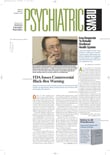Schizophrenic, agitated, noncompliant with medication, possibly substance abusing—this is the picture of the typical person who comes to the psychiatric emergency department at St. Vincent's Charity Hospital in Cleveland, according to chief psychiatrist Philipp Dines, M.D.
The picture is not different from that seen in emergency departments elsewhere around the country.
A report in the February Academic Emergency Medicine confirmed a sharp increase in the number of mentally ill persons coming to the nation's emergency departments between 1992 and 2000.
Sara Hazlett, M.D., and colleagues at Johns Hopkins University School of Medicine reported that approximately 4.3 million psychiatric-related ED visits (PREDVs) occurred in the United States in 2000. The PREDV rates increased 15 percent between 1992 and 2000, and accounted for 5.4 percent of all ED visits in 2000.
A PREDV was defined as any visit in which one of three diagnoses included a psychiatric discharge diagnosis or suicide attempt coded according to the International Classification of Diseases, Ninth Revision, Clinical Modification (ICD-9-CM), using codes 290-312.
Substance abuse (27 percent), neuroses (26 percent), and psychoses (21 percent) were the most common conditions. (Neuroses in the ICD-9-CM refers to anxiety, hysteria, and phobic disorders.) Other disorders included depression, personality and conduct disorders, and suicide or self-inflicted injury.
African Americans had significantly higher visit rates than whites, and persons on Medicaid had double the rate of PREDVs compared with the uninsured, and almost eight times the rate of those privately insured.
Patients with psychiatric diagnoses had a higher admission rate (22 percent) than those with nonpsychiatric diagnoses (15 percent).
The uninsured were the least likely to be admitted for all major psychiatric conditions except suicide.
Emergency psychiatrist Michael H. Allen, M.D., believes the ED is an untapped reservoir of information about a critical segment of mentally ill Americans and the care they receive. While the ED does serve as a kind of barometer for the dysfunctions of the larger system—the canary in the health system coal mine—the picture that emerges is impressionistic and lacking in detail.
“There are no multicenter data about who shows up in the ED, what their problems are, and what happens after they come to the ED,” Allen said. “One of the things I would like to see is a multisite system of psychiatric surveillance to look at agitation, aggression, use of restraints, and suicide—these are major public health issues.
“Suicide is the thing we are most interested in, but over the years there have been lots of things that manifested in emergency settings that could have been studied at that level and addressed. But people have not put the resources into understanding those problems.” ▪
